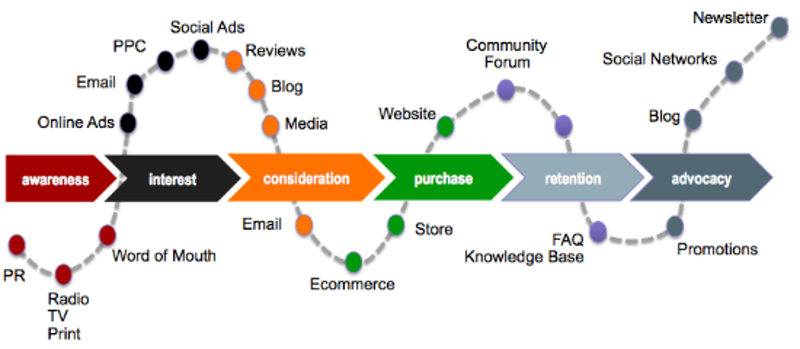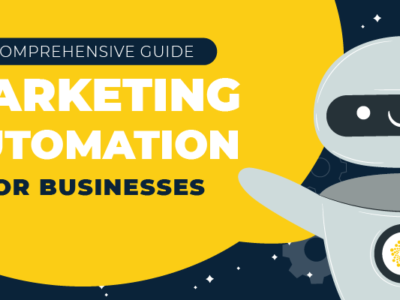Automating your marketing without thinking about customer journey is aimless. It’s like driving customers to a destination you don’t know how to get to. Ideally, both must be weaved together to guarantee success.
Creating customer journeys can help you visualize exactly how customers should go through the entire process. Using a map, you can define the different stages in the journey (awareness, consideration, decision, loyalty, and advocacy) as well as the touchpoints for engagement. Customer journeys can also serve as your guide to produce targeted content aimed at addressing the unique problems of your personas at each stage.
Meanwhile, the advanced features of a marketing automation software can execute campaigns that systematically drive prospects through the customer journey until they reach a desired destination, which is usually either conversion, loyalty, or advocacy.
How to Set Up Marketing Automation with the Customer Journey in Mind
 (Source: Econsultancy)
(Source: Econsultancy)
There’s no doubt that some will be at a different stage of the buying process than others. For instance, some customers need more time and information to weigh their options and arrive at a firm decision. In such a case, you should feed them with educative content to solve their informational needs.
Others could be losing interest in your business and starting to get detached from your campaigns. This calls for a re-engagement campaign to steer them back on the conversion path. No matter what type of personas you’re dealing with, creating customer journeys for each of them will add value to the experience and increase your chances of conversion.
With the customer journey in mind, automating your marketing should be easy. Follow these tips to ensure that your marketing automation efforts are on the right track:
-
Segment your List
Not all customers are made equal. By segmenting your email list, you recognize the fact that customers shouldn’t be on the same journey together.
There are many ways you can segment your email list. It can be based on demographics, interests or location. Looking at online activity and past interactions can help you determine which path they should follow. Here, you can create separate email lists for customers who are still assessing their options on your website and loyal customers who are prime candidates for your referral program. You can use referral marketing software to set up and manage your own referral programs.
From there, you can create a separate workflow in your marketing automation software to send them targeted content designed to set them on the right path.
-
Create a Welcome Series
The best moment to send an email to customers is right when they sign up, since this is when they are most engaged. In fact, a study showed that on average, welcome emails have 4 times higher open rates and 5 times higher click-through rates than a standard marketing email.
By utilizing triggers, a welcome email can be automatically sent to customers with the goal of keeping them engaged. Depending on your business type, your welcome email should incentivize action. You can include an exclusive offer or a special discount to encourage their first purchase. Alternatively, a series of informative blog posts or downloadable eBooks can help nurture them to the next stage of the journey.
-
Use Behavioral Triggers
By setting up behavioral triggers, you can use your customer’s online activity to send them more relevant offers that will more likely appeal to them. Here, you are responding according to their behavioral data in the most appropriate way to move them through the journey.
For instance, lapsed customers who have become disengaged with your emails for 3 months can be automatically added to a workflow designed for re-engagement. Customers who frequent a certain product page can be automatically sent an email containing discounts for their desired offer. Bottom line, behavioral triggers allow you to quickly act on what really matters to your customer.
-
Create Content and Messages Tailored to Each Trigger and/or Segment
A DMA study showed that segmented, targeted and personalized emails generate 58% of all revenue. So, when you set up triggers or segment your contacts, be sure that customers receive content that’s highly-personalized and relevant to their needs.
You can do this by providing location-based offers or separating content for male and female customers (if applicable). On the other hand, an eCommerce site can use triggers so that customers who purchase a smartphone can be recommended with smartphone accessories to maximize cross-selling opportunities.
Marketing Automation with a Purpose
Although marketing automation facilitates better tracking and personalization, it’s up to brands to determine how to extract value from the data that gets collected. Matching automation to the various stages in your customer journey isn’t just a good idea, it’s a must.
You don’t want to lose customers just because your marketing automation is losing its way. Make sure you’re going in the right direction. Use customer journeys to guide your marketing automation strategies and improve your chances of success.
Contact us today to learn about our best-in-class marketing automation services!




